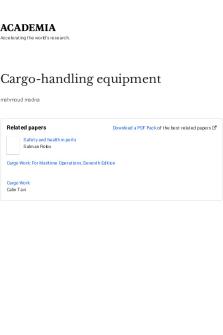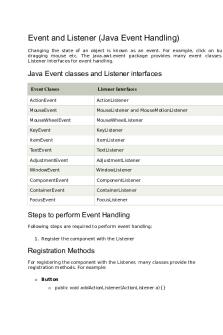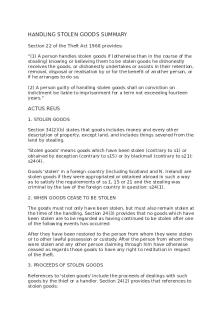Handling solutions PDF

| Title | Handling solutions |
|---|---|
| Author | Christian Stever |
| Course | Automatic Controls |
| Institution | Tennessee Technological University |
| Pages | 31 |
| File Size | 1.9 MB |
| File Type | |
| Total Downloads | 86 |
| Total Views | 138 |
Summary
MecLab Handling Excercise Answers...
Description
Handling Station Solution to exercise 1: Learning about components and their function Learning objective Upon completing this exercise, you should • be familiar with the key components in the handling station Problem description All automated systems use a range of components such as sensors, valves, motors, etc. It is important to be familiar with the function of the components within a system. Task 1. Match the components with their correct designation and describe their purpose within the station.
•
Aids Theory book
• •
FluidSIM® online help Data sheets
© 2007 Festo Didactic GmbH & Co. KG • MecLab
®
U
1
Handling Station Exercise Solutions
Name:
Class:
Date:
1. Match the components with their correct designation and describe their purpose within the station. No.
Designation
Function within the station
1
Magnetic proximity sensor
Outputs a signal when a piston passes the sensor
2
Double-acting cylinder
Drive for movement in the z direction
(guided)
3
Gripper
Grips the workpiece
4
Storage plate
Stores workpieces
5
Multi-pin plug distributor
Provides the electrical connection for the sensors and actuators
6
One-way flow control valve
Regulates the speed of the cylinders
7
Double-acting cylinder
Drive for movement in the x direction
(guided)
2
8
Magnetic proximity sensor
Outputs a signal when a piston passes the sensor
9
Solenoid valves
Control the movement of the cylinders
10
3/2-way hand valve
Shuts off the compressed air supply
11
Cable duct
Routes the cables
U
© 2007 Festo Didactic GmbH & Co. KG • MecLab
®
Handling Station Exercise Solutions
Handling Station Solution to exercise 2: Learning about components, symbols and designations Learning objective Upon completing this exercise, you should • be familiar with the symbols and designations of key pneumatic components Problem description All automated systems use a range of components such as sensors, valves, motors, etc. It is important to describe the function of the system clearly and simply. This is done using, among other things electrical, pneumatic and hydraulic circuit diagrams. To understand these circuit diagrams, you must be familiar with the symbols used. Task 1. Match the components with the correct symbols and designations. Do this by entering the number assigned to the component in the correct fields in the "Symbol" and "Designation" columns.
•
Aids Theory book
• •
FluidSIM® online help Data sheets
© 2007 Festo Didactic GmbH & Co. KG • MecLab
®
U
3
Handling Station Exercise Solutions
Name:
Class:
Date:
2. Match the components with the correct symbols and designations. Do this by entering the number assigned to the component in the correct fields in the "Symbol" and "Designation" columns. Component
Symbol
Designation
1
[ 2 ]
[ 2 ] One-way flow control valve
2
3
[ 3 ]
[ 6 ]
4
2
1
3
Double-acting cylinder
[ 3 ]
[ 1 ]
4/2-way single solenoid valve
4
5
[ 5 ]
[ 6 ]
[ 1 ] 4
2
1
3
Gripper
[ 4 ] Inductive proximity sensor
6
[ 4 ]
[ 5 ] 4/2-way double solenoid valve
4
U
© 2007 Festo Didactic GmbH & Co. KG • MecLab
®
Handling Station Exercise Solutions
Handling Station Solution to exercise 3: Learning about the structure of symbols Learning objective Upon completing this exercise, you should • be familiar with the symbol and designation of key pneumatic components • be familiar with the structure of the symbols Problem description All automated systems use a range of components such as sensors, valves, motors, etc. It is important to describe the function of the system clearly and simply. This is done using, among other things, circuit diagrams. There are electrical, pneumatic and hydraulic circuits. To understand these circuit diagrams, you must be familiar with the symbols used. This exercise is designed to teach you about the symbols. Task 3. The circuit diagram for the handling station is shown below. Describe the function of the numbered components.
• •
Aids Theory book FluidSIM® online help
•
Data sheets
© 2007 Festo Didactic GmbH & Co. KG • MecLab
®
U
5
Handling Station Exercise Solutions
Name:
Class:
Date:
4. The circuit diagram for the handling station is shown below. Describe the function of the numbered components.
6
U
© 2007 Festo Didactic GmbH & Co. KG • MecLab
®
Handling Station Exercise Solutions
Name:
Class:
Number
Function
a
Pneumatic circuit
b
Electrical circuit
1
Double-acting cylinder
Date:
Converts pneumatic energy into mechanical energy.
2
4/2-way double solenoid valve Switches to the opposite switching position by means of a current pulse.
3
4/2-way single solenoid valve Switches to the open switching position as long as there is current flowing through the solenoid coil. Resetting is performed by a pneumatic spring.
4
One-way flow control valve Regulates the speed of the double-acting cylinder.
5
Magnetic sensor (proximity sensor) Outputs a signal when the cylinder piston approaches it (piston contains a permanent magnet).
6
Programmable logic controller (logic module) Processes the sensor signals and controls the solenoid coils.
7
Solenoid coils These actuate the solenoid coils of the solenoid valves in the electrical circuit.
8
On/off switch
9
Magnetic sensors (proximity sensors) These provide position feedback in the pneumatic circuit.
© 2007 Festo Didactic GmbH & Co. KG • MecLab
®
U
7
Handling Station Exercise Solutions
Handling Station Solution to exercise 4: Creating schematic and circuit diagrams Learning objective Upon completing this exercise, you should • be able to create schematic diagrams, pneumatic circuit diagrams and allocation lists Problem description Engineers use schematic diagrams, technical drawings, part lists or circuit diagrams to represent machines or machine parts efficiently and clearly. Task 5. Create a schematic diagram for the handling station pictured, showing the function and position of the key components. 6. Create an allocation list that specifies which sensor or actuator is plugged into which slot on the multi-pin plug distributor. 7. Create a pneumatic circuit diagram of the station using FluidSIM®.
• •
Aids Theory book FluidSIM®
•
Handling station
Picture of the station
8
U
© 2007 Festo Didactic GmbH & Co. KG • MecLab
®
Handling Station Exercise Solutions
Name:
Class:
Date:
8. Create a schematic diagram for the handling station pictured, showing the function and position of the key components.
9. Create an allocation list that specifies which sensor or actuator is plugged into which slot on the multi-pin plug distributor. Slot
Designation
Description
0
1S1
Magnetic proximity sensor at cylinder 1A, rear
2
1S2
Magnetic proximity sensor at cylinder 1A, front
4
2S1
Magnetic proximity sensor at cylinder 2A, top
6
2S2
Magnetic proximity sensor at cylinder 2A, bottom
1
1M1
Advance cylinder 1
3
1M2
Retract cylinder 1
5
2M1
Advance cylinder 2
7
2M2
Retract cylinder 2
9
3M1
Close gripper
© 2007 Festo Didactic GmbH & Co. KG • MecLab
®
U
9
Handling Station Exercise Solutions
Name:
Class:
Date:
10. Create a pneumatic circuit diagram of the station using FluidSIM®.
10
U
© 2007 Festo Didactic GmbH & Co. KG • MecLab
®
Handling Station Exercise Solutions
Handling Station Solution to exercise 5: Controlling a double-acting cylinder Learning objective Upon completing this exercise, you should • be able to select the components of an electropneumatic circuit • be able to design electropneumatic circuits • be able to actuate a double-acting cylinder using FluidSIM® Problem description Workpieces are to be lifted using a pneumatic cylinder. A control system is to be designed for this purpose. A vertically arranged double-acting cylinder equipped with one-way flow control valves is provided for lifting. This cylinder is to be supplied with air by means of a solenoid valve and controlled via PC. The cylinder should advance when a pushbutton is actuated and retract after a second pushbutton is actuated. Task 11. Select a suitable valve from the four available and explain the reasons for your choice. 12. Design a pneumatic circuit diagram for the components you selected and test its function via simulation. 13. Complete the electrical circuit diagram with the suitable actuating elements and transfer the solution to FluidSIM®. Test its function via simulation. 14. For safety reasons the cylinder should advance slowly, but retract quickly. How can this be achieved? Test your solution via simulation. 15. Extend the circuit so that the vertically arranged cylinder of the handling station can be controlled and test its operability. What do you have to do so that the actual cylinder also advances slowly and retracts quickly? 16. How can you arrange it so that the cylinder automatically retracts upwards after reaching the advanced (lower) end position? Modify the circuit and test the result.
• •
Aids Theory book FluidSIM®
•
Handling station
© 2007 Festo Didactic GmbH & Co. KG • MecLab
®
U
11
Handling Station Exercise Solutions
Name:
Class:
Date:
17. Select a suitable valve from the four available and explain the reasons for your choice. a 4/2-way double solenoid valve b 4/2-way single solenoid valve c 3/2-way normally closed solenoid valve d 3/2-way normally closed valve, manually actuated
The manually-actuated valve is not suitable for the task because it cannot be controlled via PC. The 3/2-way solenoid valve does not have enough ports (1) for the double-acting cylinder. The 4/2-way single solenoid valve is reset by a pneumatic spring as soon as the control current is switched off, i.e. the cylinder would retract immediately if the pushbutton were released. Only the 4/2-way double solenoid valve is suitable. It stores the switching position until another reversing pulse is received. 18. Entwerfe einen pneumatischen Schaltplan aus den gewählten Komponenten und teste die Funktion in der Simulation. Nutze dazu FluidSIM®. Die notwendigen Komponenten sind der doppeltwirkende Zylinder, das gewählte Ventil, zwei Drosselrückschlagventile und eine Druckluftquelle. Teste die Schaltung im Simulationsmodus, indem Du die Handhilfsbetätigung des Ventils mit der Maus anklickst.
12
U
© 2007 Festo Didactic GmbH & Co. KG • MecLab
®
Handling Station Exercise Solutions
Name:
Class:
Date:
19. Complete the electrical circuit diagram with a suitable actuating component. The actuating components available are (see illustration):
a) pushbutton (N/O contact), b) detenting pushbutton (N/O contact), c) pushbutton (N/C contact), d) detenting pushbutton (N/C contact).
The pushbutton is suitable since the double solenoid valve only needs one current pulse to reverse.
20. For safety reasons the cylinder should advance slowly, but retract quickly. How can this be achieved? Test your solution via simulation. To facilitate this, the opening of the one-way flow control valve 2V3 must be reduced (double-click on the valve). This restricts the flow of air coming out of the front cylinder chamber and the cylinder advances more slowly. The one-way flow control valve 2V2 remains fully open.
© 2007 Festo Didactic GmbH & Co. KG • MecLab
®
U
13
Handling Station Exercise Solutions
Name:
Class:
Date:
21. Extend the circuit so that the cylinder of the handling station can be controlled and test its operability. Do this by extending the circuit diagram to include the multi-pin plug symbol and assign the designation for the solenoid coil to the slot where the solenoid coil is actually plugged in. What do you have to do so that the actual cylinder also advances slowly and retracts quickly? The actual one-way flow control valve must also be adjusted to get the actual cylinder to advance more slowly.
22. How can you arrange it so that the cylinder automatically retracts upwards after reaching the advanced (lower) end position? Modify the circuit and test the result. The magnetic proximity sensor 2S2 switches when the cylinder reaches the advanced (= lower) end position. This signal can be used instead of the UP pushbutton to reverse the valve 2V1.
14
U
© 2007 Festo Didactic GmbH & Co. KG • MecLab
®
Handling Station Exercise Solutions
Handling Station Solution to exercise 6: Learning about logic operations Learning objective Upon completing this exercise, you should • be familiar with the most important logic operations • be able to create logic programs in FluidSIM® •
be able to solve simple control tasks using logic operations
Problem description Logic operations are an important basis of control technology. In the FluidSIM® logic module, inputs and outputs are linked using logic operations. This exercise deals with the most important logic operations. Task 23. Transfer the following logic circuits to FluidSIM® and study the circuit's behaviour by setting the input channels I1 through I3 to the status 'high' by clicking on them. Complete the truth table. In each case specify an example of a control task that can be solved using this logic operation. 24. Create the logic circuit shown below in FluidSIM®, test its behaviour and describe it. What control tasks can this so-called latching element be used for? 25. Create the circuit shown below in FluidSIM®. Open the logic module and create a program with the following characteristics: • Lamp P1 should light up when the two pushbuttons T1 and T2 are pressed (and stay on after pushbuttons T1 and T2 have been released). • The lamp should switch off when pushbuttons T3 or T4 are actuated. 26. Extend the circuit from Exercise 3 so that an electric motor is switched on and off instead of the lamp.
• •
Aids Theory book FluidSIM®
© 2007 Festo Didactic GmbH & Co. KG • MecLab
®
U
15
Handling Station Exercise Solutions
Name:
Class:
Date:
27. Transfer the following logic circuits to FluidSIM® and study the circuit's behaviour by setting the input channels I1 through I3 to the status 'high' by clicking on them. Complete the truth table. In each case specify an example of a control task that can be solved using this logic operation. I1
I2
I3
Q1
0
0
0
0
0
0
1
0
0
1
0
0
0
1
1
0
1
1
1
1
1
1
0
0
1
0
1
0
1
0
0
0
I1
I2
I3
Q1
0
0
0
0
0
0
1
1
0
1
0
1
0
1
1
1
1
1
1
1
1
1
0
1
1
0
1
1
1
0
0
1
Example of a control task: Activate when all three inputs are 1 (AND).
Example of a control task: Activate when at least one input is 1 (OR).
16
U
© 2007 Festo Didactic GmbH & Co. KG • MecLab
®
Handling Station Exercise Solutions
Name:
Class:
Date:
I1
Q1
0
1
1
0
I1
I2
Q1
0
0
1
0
1
0
1
0
0
1
1
0
Example of a control task: Activate when pushbutton (N/C contact) is pressed (NOT).
Example of a control task: Deactivate as soon as a pushbutton is pressed.
© 2007 Festo Didactic GmbH & Co. KG • MecLab
®
U
17
Handling Station Exercise Solutions
Name:
Class:
Date:
28. Create the logic circuit shown below in FluidSIM®, test its behaviour and describe it. What control tasks can this so-called latching element be used for?
Input I1 sets the output Q1. This remains 1 until input I2 is set (latching element).
18
U
© 2007 Festo Didactic GmbH & Co. KG • MecLab
®
Handling Station Exercise Solutions
Name:
Class:
Date:
29. Create the circuit shown below in FluidSIM®.
–
Open the logic module and create a program with the following characteristics: • Lamp P1 should light up when the two pushbuttons T1 and T2 are pressed (and stay on after pushbuttons T1 and T2 have been released). • The lamp should switch off when pushbuttons T3 or T4 are actuated.
© 2007 Festo Didactic GmbH & Co. ...
Similar Free PDFs

Handling solutions
- 31 Pages

MAKALAH MATERIAL HANDLING
- 8 Pages

C error handling
- 3 Pages

Cargo-handling equipment
- 22 Pages

Handling stolen goods summary
- 3 Pages

Event Handling IN JAVA
- 6 Pages

Sitxfsa001 food handling
- 14 Pages

METHODS OF HANDLING DEADLOCK
- 2 Pages

Advantages of exception handling
- 2 Pages

Exception & File Handling
- 56 Pages

Workshop 08-Tran-Handling
- 5 Pages

Handling stolen goods
- 3 Pages

ORDER HANDLING My IndiHome
- 37 Pages

Makalah Material Handling
- 14 Pages
Popular Institutions
- Tinajero National High School - Annex
- Politeknik Caltex Riau
- Yokohama City University
- SGT University
- University of Al-Qadisiyah
- Divine Word College of Vigan
- Techniek College Rotterdam
- Universidade de Santiago
- Universiti Teknologi MARA Cawangan Johor Kampus Pasir Gudang
- Poltekkes Kemenkes Yogyakarta
- Baguio City National High School
- Colegio san marcos
- preparatoria uno
- Centro de Bachillerato Tecnológico Industrial y de Servicios No. 107
- Dalian Maritime University
- Quang Trung Secondary School
- Colegio Tecnológico en Informática
- Corporación Regional de Educación Superior
- Grupo CEDVA
- Dar Al Uloom University
- Centro de Estudios Preuniversitarios de la Universidad Nacional de Ingeniería
- 上智大学
- Aakash International School, Nuna Majara
- San Felipe Neri Catholic School
- Kang Chiao International School - New Taipei City
- Misamis Occidental National High School
- Institución Educativa Escuela Normal Juan Ladrilleros
- Kolehiyo ng Pantukan
- Batanes State College
- Instituto Continental
- Sekolah Menengah Kejuruan Kesehatan Kaltara (Tarakan)
- Colegio de La Inmaculada Concepcion - Cebu

